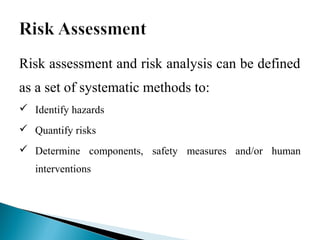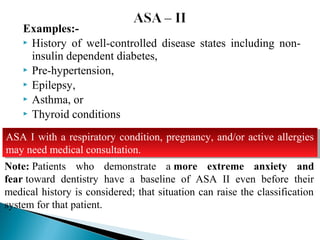Risk assessment - medical
- 1. Presented By Aves Khan BDS III Year * Fehrenbach, Margaret, ASA Physical Status Classification System for Dental Professionals at http://www.dhed.net/ASA_Physical_Status_Classification_SYSTEM.html
- 2. • Hazard: the property of a substance or situation with the potential for creating damage • Risk: the likelihood of a specific effect within a specified period –complex function of probability, consequences and vulnerability
- 3. Risk assessment and risk analysis can be defined as a set of systematic methods to:  Identify hazards  Quantify risks  Determine components, safety measures and/or human interventions
- 4. Classification: By American Society of Anesthologists (1963) – ASA 1: Normal health ASA 2: Mild systemic disease ASA 3: Severe systemic disease ASA 4: Severe systemic disease - constant threat to life ASA 5: Critically ill patient ASA 6: Brain dead E: Emergency surgery
- 5. ÔÅΩ Patients are able to walk up one flight of stairs or two level city blocks without distress. ÔÅΩ Little or no anxiety. ÔÅΩ Little or no risk. This classification represents a "green flag" for treatment.
- 6. ÔÅΩ Patients are able to walk up one flight of stairs or two level city blocks, but will have to stop after completion of the exercise because of distress. ÔÅΩ Minimal risk during treatment. This classification represents a "yellow flag" for treatment.
- 7. Examples:- ÔÅΩ History of well-controlled disease states including non- insulin dependent diabetes, ÔÅΩ Pre-hypertension, ÔÅΩ Epilepsy, ÔÅΩ Asthma, or ÔÅΩ Thyroid conditions ASA I with a respiratory condition, pregnancy, and/or active allergies may need medical consultation. ASA I with a respiratory condition, pregnancy, and/or active allergies may need medical consultation. Note: Patients who demonstrate a more extreme anxiety and fear toward dentistry have a baseline of ASA II even before their medical history is considered; that situation can raise the classification system for that patient.
- 8. ÔÅΩ Patients are able to walk up one flight of stairs or two level city blocks, but will have to stop because of distress. ÔÅΩ If dental care is indicated, stress reduction protocol and other treatment modifications are indicated. This classification represents a "yellow flag" for treatment.
- 9. Examples:- ÔÅΩ History of angina pectoris, ÔÅΩ Myocardial infarction, or cerebrovascular accident, ÔÅΩ Congestive heart failure over six months ago, ÔÅΩ Slight chronic obstructive pulmonary disease, and ÔÅΩ Controlled insulin dependent diabetes or hypertension.
- 10. ÔÅΩ Patients are unable to walk up one flight of stairs or two level city blocks. ÔÅΩ Distress is present even at rest. ÔÅΩ Patients pose significant risk since patients in this category have a severe medical problem of greater importance to the patient than the planned dental treatment.
- 11. ÔÅΩ Whenever possible, elective dental care should be postponed until such time as the patient's medical condition has improved to at least an ASA III classification. This classification represents a "red flag" a warning‚Äë flag.
- 12. Examples:- ÔÅΩ History of unstable angina pectoris, ÔÅΩ Myocardial infarction or cerebrovascular accident within the last six months, ÔÅΩ Severe congestive heart failure, ÔÅΩ Moderate to severe chronic obstructive pulmonary disease, ÔÅΩ Uncontrolled diabetes, hypertension, epilepsy, or thyroid condition. If emergency treatment is needed, medical consultation is indicated.
- 13.  These patients are almost always hospitalized, terminally ill patients.  Elective dental treatment is definitely contraindicated;  However, emergency care, in the realm of palliative treatment may be necessary. This classification represents a “red flag" for dental care and any care is done in a hospital situation.

















